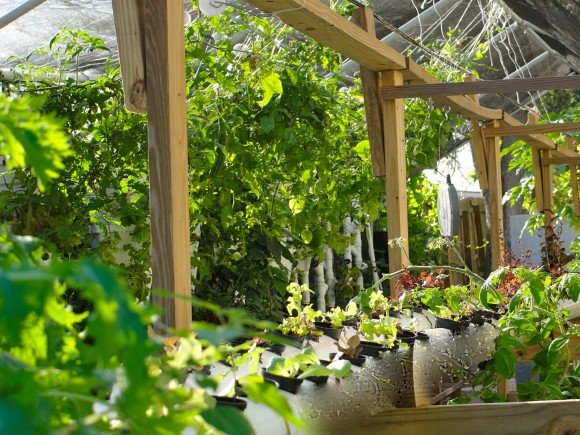
Recirculating Farms
by: Recirculating Farms Coalition: Shaylyn Berlew Posted on: January 12, 2012
Photo: Sahib’s Florida Aquaponic Farm, courtesy of Recirculating Farms Coalition
By Shaylyn Berlew, Communications Intern, Recirculating Farms Coalition
Editor’s Note: The Recirculating Farms Coalition, based out of New Orleans, tells us of an interesting way to create jobs and sustainably grow food. Recirculating farms can be implemented practically anywhere, including the Great Northwest, which is why we place this piece in our Dirt section, where articles on Northwest food security, agriculture, and mud are featured.
There’s no denying it—the U.S. is currently in a precarious economic and environmental state. With an unemployment rate of 9.1 percent, a dire need for sustainable food and energy, and endless controversy about how to solve these problems, our future can often seem daunting.
How can stable jobs and healthy food be provided for communities affordably, without more environmental repercussions? An innovative method of farming could help answer several of these issues currently plaguing the United States. Using a closed-loop system, recirculating farms recycle almost all of the resources they use. The farms not only produce sustainably-grown plants, vegetables, fruit, and fish, but also can create green jobs in a growing industry.
What is a recirculating farm? To put it simply, these farms use water instead of soil to cultivate food. The water is constantly being filtered, recycled, and circulated through the farm. The farms can be located outdoors, but if an area’s climate isn’t conducive to this, they can be located in a greenhouse or other indoor structure. (Want a better idea of what this looks like? Check out this photo gallery)
Recirculating farms can grow plants (hydroponics), fish (on-land aquaculture), or a combination of both plants and fish (aquaponics). Plants and fish grown together form a symbiotic relationship; plants absorb essential nutrients from the fish water and in doing so, “clean” the water to reuse in the fish tanks. (Learn more about aquaponics in this video about a recirculating farm in New York)
Because recirculating farms don’t need to be connected to a natural water source, there’s no threat of fish escaping into the wild.
Recirculating farms can actually produce more food in less space than other forms of agriculture and aquaculture. In nine months, certain fish in a recirculating farm can be grown to market size—this can take up to 15-18 months in other farming systems.
Recirculating farms are relatively simple and inexpensive to build, and the versatility of the system makes it possible for these farms to be located just about anywhere. Plants and fish can be produced year-round on land that might otherwise be considered unusable, even in densely populated urban areas, where food is often needed most. Local farms provide people with genuine local food and jobs. Growing food right in the community where it’s used means reduction of food shipping costs, fuel, and carbon emissions – when food is being grown locally, it doesn’t need to be transported very far or imported from elsewhere.
The benefits of recirculating farms are significant; they can create sustainable food and job opportunities anywhere, without hurting the environment. In the midst of economic turmoil, recirculating farms can provide fresh, local, sustainable food and green jobs. To learn more – check out the Recirculating Farms Coalition – www.recirculatingfarms.org
One Response to “Recirculating Farms”
Articles On Dirt
Dirt: Dirt
- Mar 6 Re-Imagining Local Public Space, From Parks to Post Offices
- Nov 7 Google Cache Snapshot-Oregonlandco.com, 9/15/13
- Nov 7 Testimony
- Nov 7 Sustainable Forestry Initiative Confirms
- Sep 8 Why Label Genetically Modified Food?
- Sep 8 Why Not Label Genetically Modified Food?
- Sep 8 When Industrial Slaughterhouses Are Proposed
- Aug 8 ¡HUELGA! Mixteco and Triqui Farmworkers commence second Work Stoppage at Sakuma Brothers Farms, Inc.
- Aug 8 Bolivia: Building Resilience To Climate Change Through Indigenous Knowledge – The Case Of Bolivia
- Jun 8 A Conversation about School Lunches, a Student and a Farmer
- Oct 21 On Kids and Food
- Sep 30 Empowered Latino Farmers (Spanish & English Translations Included)
- Sep 16 Whatcom Farm-to-School: Tackling Food System Challenges One Lunch at a Time
- Aug 10 Sludge, Whose Jurisdiction? (Part 2)
- Jul 30 Sludge, Whose Jurisdiction? (Part 1)
- Jul 9 Rethinking the Peasant
- Jun 25 The Beginning of Regional Food Governance?
- May 29 Urban and Suburban Agriculture Empowers Environmental Stewards
- May 13 Northwest Soil Science: Nitrogen Mineralization
- Feb 3 WA Conservation Districts: An Introduction
- Jan 20 Planning For A Future: Protecting The Ground
- Jan 12 Recirculating Farms
- Dec 30 Columbia Basin Water Development
- Jan 25 No Fisherman Deserves a Toxic River
- Dec 15 Conserving Working Lands, Native Species, and Fertile Soil
- Nov 1 Protecting Dirt, Among Other Things
- Oct 25 Coming Soon


by: Pweng Beeon: Monday 2nd of July 2012